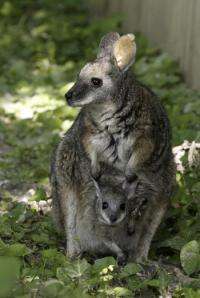September 30, 2015 report
Artificial light found to negatively impact wallabies

(Phys.org)—A team of researchers from Australia and Germany has found that at least one species of mammal is negatively impacted by artificial lighting. In their paper published in Proceedings of the Royal Society B, the team describes a field study they conducted on an island off the coast of Australia and what they found by doing so.
Scientists have been aware for some time that artificial lighting has an impact on wildlife, some of it negative—migrating birds, for example, have been found to go off course due to light from below. Other studies have been conducted, the researchers with this new effort report, but not many have been done in the wild to ascertain an overall impact on a species. To learn more, they ventured off the South-Western coast of Australia, near Perth, to Garden Island—two populations of wallaby live there, one to the north where conditions are more wild, with little to no artificial light, and one in the south, where there is a very large, well lit naval base.
The researchers captured five female wallabies from each group and fitted them each with collars that had light sensors, GPS coordinate monitors and a radio to broadcast data to the team. They also captured an additional 70 females and took blood samples. Because the study was mainly focused on the association between exposure to artificial light at night and reproduction schedules, the team also monitored the births of 300 baby wallabies born on the island—all over a five year period.
In studying the data, the researchers discovered that the females that lived near the base had much less melatonin in their blood, a hormone that helps to regulate sleep cycles. It also plays a role in raising or lowering the level of progesterone, which in turn has an impact on when a baby is born. The team found that babies born to the wallabies near the base came a month later than for those living in the wild.
The timing of births for wallabies is critical, the researchers note, because it needs to happen during the time of year when the mother has the right food in the right amounts to properly nurse her young. In the case of the babies born on the naval base, that was not a problem because the wallabies ate the grass that grew on the lawns there, but babies in the wild, the team suspects, would find themselves cast away if the mother did not have enough to eat to support them.
More information: Artificial light at night desynchronizes strictly seasonal reproduction in a wild mammal, Proceedings of the Royal Society B, Published 30 September 2015. DOI: 10.1098/rspb.2015.1745
Abstract
Change in day length is an important cue for reproductive activation in seasonally breeding animals to ensure that the timing of greatest maternal investment (e.g. lactation in mammals) coincides with favourable environmental conditions (e.g. peak productivity). However, artificial light at night has the potential to interfere with the perception of such natural cues. Following a 5-year study on two populations of wild marsupial mammals exposed to different night-time levels of anthropogenic light, we show that light pollution in urban environments masks seasonal changes in ambient light cues, suppressing melatonin levels and delaying births in the tammar wallaby. These results highlight a previously unappreciated relationship linking artificial light at night with induced changes in mammalian reproductive physiology, and the potential for larger-scale impacts at the population level.
Journal information: Proceedings of the Royal Society B
© 2015 Phys.org




















